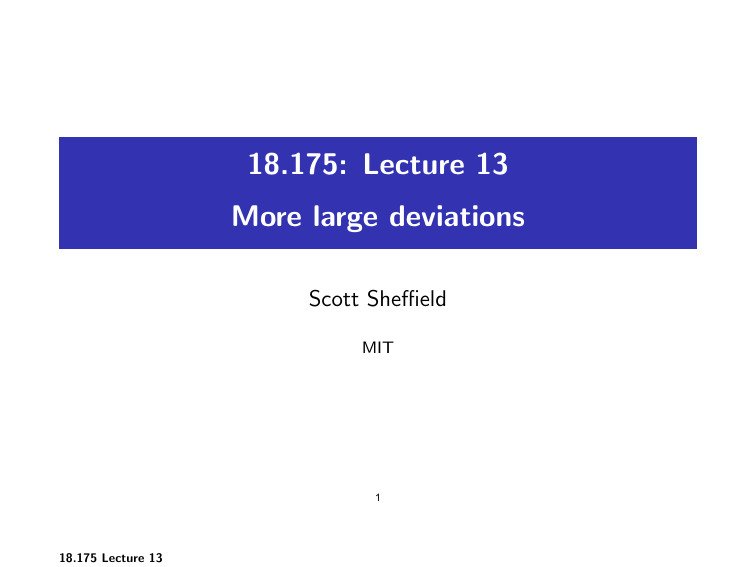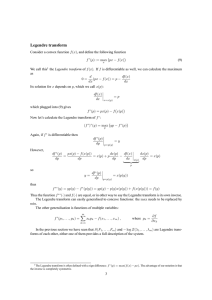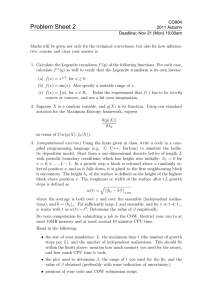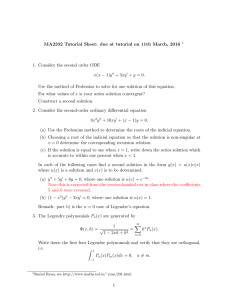Document 13424482
advertisement

18.175: Lecture 13
More large deviations
Scott Sheffield
MIT
1
18.175 Lecture 13
Outline
Legendre transform
Large deviations
2
18.175 Lecture 13
Outline
Legendre transform
Large deviations
3
18.175 Lecture 13
Legendre transform
�
Define Legendre transform (or Legendre dual) of a function
Λ : Rd → R by
Λ∗ (x) = sup {(λ, x) − Λ(λ)}.
λ∈Rd
�
�
�
�
�
�
Let’s describe the Legendre dual geometrically if d = 1: Λ∗ (x)
is where tangent line to Λ of slope x intersects the real axis.
We can “roll” this tangent line around the convex hull of the
graph of Λ, to get all Λ∗ values.
Is the Legendre dual always convex?
What is the Legendre dual of x 2 ? Of the function equal to 0
at 0 and ∞ everywhere else?
How are derivatives of Λ and Λ∗ related?
What is the Legendre dual of the Legendre dual of a convex
function?
What’s the higher dimensional analog of rolling the tangent
line?
4
18.175 Lecture 13
Outline
Legendre transform
Large deviations
5
18.175 Lecture 13
Outline
Legendre transform
Large deviations
6
18.175 Lecture 13
Recall: moment generating functions
�
I
I
�
I
�
I
�
I
�
I
�
I
�
Let X be a random variable.
The moment generating function of X is defined by
M(t) = MX (t) := E [e tX ].
When X is discrete, can write M(t) = x e tx pX (x). So M(t)
is a weighted average of countably many exponential
functions.
∞
When X is continuous, can write M(t) = −∞ e tx f (x)dx. So
M(t) is a weighted average of a continuum of exponential
functions.
We always have M(0) = 1.
If b > 0 and t > 0 then
E [e tX ] ≥ E [e t min{X ,b} ] ≥ P{X ≥ b}e tb .
If X takes both positive and negative values with positive
probability then M(t) grows at least exponentially fast in |t|
as |t| → ∞.
7
18.175 Lecture 13
Recall: moment generating functions for i.i.d. sums
�
I
We showed that if Z = X + Y and X and Y are independent,
then MZ (t) = MX (t)MY (t)
�
I
If X1 . . . Xn are i.i.d. copies of X and Z = X1 + . . . + Xn then
what is MZ ?
�
I
Answer: MXn .
8
18.175 Lecture 13
Large deviations
�
I
Consider i.i.d. random variables Xi . Can we show that
P(Sn ≥ na) → 0 exponentially fast when a > E [Xi ]?
�
I
Kind of a quantitative form of the weak law of large numbers.
The empirical average An is very unlikely to E away from its
expected value (where “very” means with probability less than
some exponentially decaying function of n).
9
18.175 Lecture 13
General large deviation principle
�
I
�
I
I
�
�
I
I
�
I
�
�
I
More general framework: a large deviation principle describes
limiting behavior as n → ∞ of family {µn } of measures on
measure space (X , B) in terms of a rate function I .
The rate function is a lower-semicontinuous map
I : X → [0, ∞]. (The sets {x : I (x) ≤ a} are closed — rate
function called “good” if these sets are compact.)
DEFINITION: {µn } satisfy LDP with rate function I and
speed n if for all Γ ∈ B,
1
1
− inf I (x) ≤ lim inf log µn (Γ) ≤ lim sup log µn (Γ) ≤ − inf I (x).
0
n→∞
n
x∈Γ
n→∞ n
x∈Γ
INTUITION: when “near x” the probability density function
for µn is tending to zero like e −I (x)n , as n → ∞.
Simple case: I is continuous, Γ is closure of its interior.
Question: How would I change if we replaced the measures
µn by weighted measures e (λn,·) µn ?
Replace I (x) by I (x) − (λ, x)? What is inf x I (x) − (λ, x)?
18.175 Lecture 13
10
Cramer’s theorem
�
I
P
Let µn be law of empirical mean An = n1 nj=1 Xj for i.i.d.
vectors X1 , X2 , . . . , Xn in Rd with same law as X .
�
I
Define log moment generating function of X by
Λ(λ) = ΛX (λ) = log MX (λ) = log Ee (λ,X ) ,
where (·, ·) is inner product on Rd .
�
I
Define Legendre transform of Λ by
Λ∗ (x) = sup {(λ, x) − Λ(λ)}.
λ∈Rd
�
I
CRAMER’S THEOREM: µn satisfy LDP with convex rate
function Λ∗ .
11
18.175 Lecture 13
Thinking about Cramer’s theorem
�
I
�
I
P
Let µn be law of empirical mean An = n1 nj=1 Xj .
CRAMER’S THEOREM: µn satisfy LDP with convex rate
function
I (x) = Λ∗ (x) = sup {(λ, x) − Λ(λ)},
λ∈Rd
I
�
�
I
where Λ(λ) = log M(λ) = Ee (λ,X1 ) .
This means that for all Γ ∈ B we have this asymptotic lower
bound on probabilities µn (Γ)
1
− inf I (x) ≤ lim inf log µn (Γ),
0
n→∞ n
x∈Γ
so (up to sub-exponential error) µn (Γ) ≥ e −n inf x∈Γ0 I (x) .
and this asymptotic upper bound on the probabilities µn (Γ)
1
lim sup log µn (Γ) ≤ − inf I (x),
n→∞ n
x∈Γ
which says (up to subexponential error) µn (Γ) ≤ e −n inf x∈Γ I (x) .
18.175 Lecture 13
12
Proving Cramer upper bound
�
I
�
I
�
I
�
I
Recall that I (x) = Λ∗ (x) = supλ∈Rd {(λ, x) − Λ(λ)}.
For simplicity, assume that Λ is defined for all x (which
implies that X has moments of all orders and Λ and Λ∗ are
strictly convex, and the derivatives of Λ and ΛN are inverses of
each other). It is also enough to consider the case X has
mean zero, which implies that Λ(0) = 0 is a minimum of Λ,
and Λ∗ (0) = 0 is a minimum of Λ∗ .
We aim to show (up to subexponential error) that
µn (Γ) ≤ e −n inf x∈Γ I (x) .
If Γ were singleton set {x} we could find the λ corresponding
to x, so Λ∗ (x) = (x, λ) − Λ(λ). Note then that
Ee (nλ,An ) = Ee (λ,Sn ) = MXn (λ) = e nΛ(λ) ,
�
I
and also Ee (nλ,An ) ≥ e n(λ,x) µn {x}. Taking logs and dividing
by n gives Λ(λ) ≥ n1 log µn + (λ, x), so that
1
∗
n log µn (Γ) ≤ −Λ (x), as desired.
General Γ: cut into finitely many pieces, bound each piece?
18.175 Lecture 13
13
Proving Cramer lower bound
�
I
Recall that I (x) = Λ∗ (x) = supλ∈Rd {(λ, x) − Λ(λ)}.
I
�
We aim to show that asymptotically µn (Γ) ≥ e −n inf x∈Γ0 I (x) .
I
�
It’s enough to show that for each given x ∈ Γ0 , we have that
asymptotically µn (Γ) ≥ e −n inf x∈Γ0 I (x) .
I
�
Idea is to weight the law of X by e (λ,x) for some λ and
normalize to get a new measure whose expectation is this
point x. In this new measure, An is “typically” in Γ for large
Γ, so the probability is of order 1.
I
�
But by how much did we have to modify the measure to make
this typical? Not more than by factor e −n inf x∈Γ0 I (x) .
14
18.175 Lecture 13
MIT OpenCourseWare
http://ocw.mit.edu
18.175 Theory of Probability
Spring 2014
For information about citing these materials or our Terms of Use, visit: http://ocw.mit.edu/terms .




